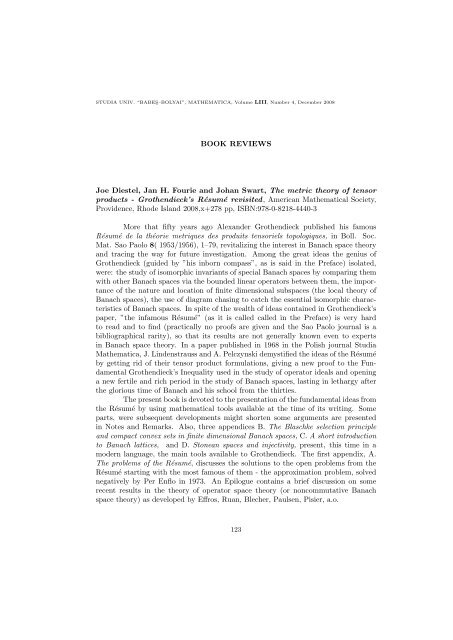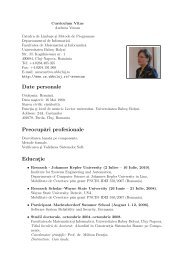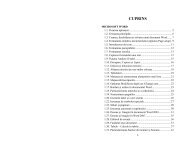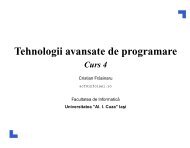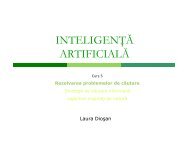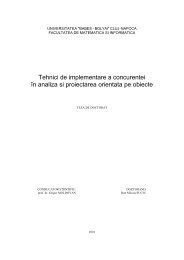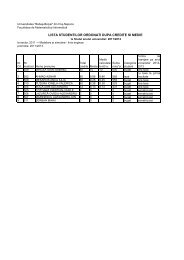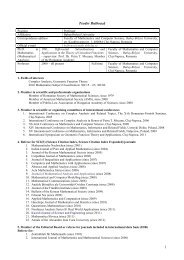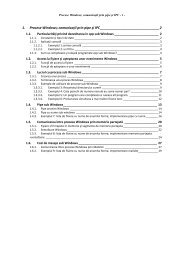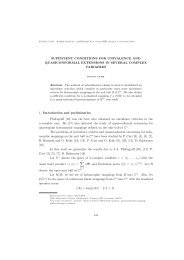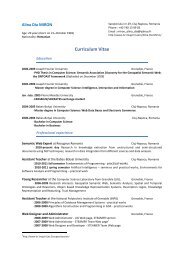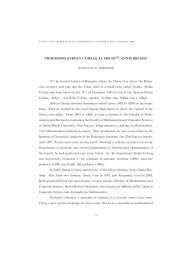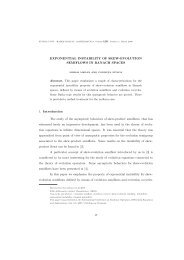BOOK REVIEWS Joe Diestel, Jan H. Fourie and Johan Swart, The ...
BOOK REVIEWS Joe Diestel, Jan H. Fourie and Johan Swart, The ...
BOOK REVIEWS Joe Diestel, Jan H. Fourie and Johan Swart, The ...
You also want an ePaper? Increase the reach of your titles
YUMPU automatically turns print PDFs into web optimized ePapers that Google loves.
STUDIA UNIV. “BABES¸–BOLYAI”, MATHEMATICA, Volume LIII, Number 4, December 2008<br />
<strong>BOOK</strong> <strong>REVIEWS</strong><br />
<strong>Joe</strong> <strong>Diestel</strong>, <strong>Jan</strong> H. <strong>Fourie</strong> <strong>and</strong> <strong>Johan</strong> <strong>Swart</strong>, <strong>The</strong> metric theory of tensor<br />
products - Grothendieck’s Résumé revisited, American Mathematical Society,<br />
Providence, Rhode Isl<strong>and</strong> 2008,x+278 pp, ISBN:978-0-8218-4440-3<br />
More that fifty years ago Alex<strong>and</strong>er Grothendieck published his famous<br />
Résumé de la théorie metriques des produits tensoriels topologiques, in Boll. Soc.<br />
Mat. Sao Paolo 8( 1953/1956), 1–79, revitalizing the interest in Banach space theory<br />
<strong>and</strong> tracing the way for future investigation. Among the great ideas the genius of<br />
Grothendieck (guided by ”his inborn compass”, as is said in the Preface) isolated,<br />
were: the study of isomorphic invariants of special Banach spaces by comparing them<br />
with other Banach spaces via the bounded linear operators between them, the importance<br />
of the nature <strong>and</strong> location of finite dimensional subspaces (the local theory of<br />
Banach spaces), the use of diagram chasing to catch the essential isomorphic characteristics<br />
of Banach spaces. In spite of the wealth of ideas contained in Grothendieck’s<br />
paper, ”the infamous Résumé” (as it is called called in the Preface) is very hard<br />
to read <strong>and</strong> to find (practically no proofs are given <strong>and</strong> the Sao Paolo journal is a<br />
bibliographical rarity), so that its results are not generally known even to experts<br />
in Banach space theory. In a paper published in 1968 in the Polish journal Studia<br />
Mathematica, J. Lindenstrauss <strong>and</strong> A. Pelczynski demystified the ideas of the Résumé<br />
by getting rid of their tensor product formulations, giving a new proof to the Fundamental<br />
Grothendieck’s Inequality used in the study of operator ideals <strong>and</strong> opening<br />
a new fertile <strong>and</strong> rich period in the study of Banach spaces, lasting in lethargy after<br />
the glorious time of Banach <strong>and</strong> his school from the thirties.<br />
<strong>The</strong> present book is devoted to the presentation of the fundamental ideas from<br />
the Résumé by using mathematical tools available at the time of its writing. Some<br />
parts, were subsequent developments might shorten some arguments are presented<br />
in Notes <strong>and</strong> Remarks. Also, three appendices B. <strong>The</strong> Blaschke selection principle<br />
<strong>and</strong> compact convex sets in finite dimensional Banach spaces, C. A short introduction<br />
to Banach lattices, <strong>and</strong> D. Stonean spaces <strong>and</strong> injectivity, present, this time in a<br />
modern language, the main tools available to Grothendieck. <strong>The</strong> first appendix, A.<br />
<strong>The</strong> problems of the Résumé, discusses the solutions to the open problems from the<br />
Résumé starting with the most famous of them - the approximation problem, solved<br />
negatively by Per Enflo in 1973. An Epilogue contains a brief discussion on some<br />
recent results in the theory of operator space theory (or noncommutative Banach<br />
space theory) as developed by Effros, Ruan, Blecher, Paulsen, Pisier, a.o.<br />
123
<strong>BOOK</strong> <strong>REVIEWS</strong><br />
<strong>The</strong> basic results of the Résumé are presented in the four chapters of the main<br />
text: 1. Basics of tensor norms, 2. <strong>The</strong> role of C(K)-spaces <strong>and</strong> L 1 -spaces, 3. ⊗norms<br />
related to Hilbert space, <strong>and</strong> 4. <strong>The</strong> fundamental theorem <strong>and</strong> its consequences<br />
(containing a proof of Grothendieck’s Fundamental Inequality).<br />
Written in an alive <strong>and</strong> entertaining style, but with detailed <strong>and</strong> rigorous<br />
proofs, the book makes available to a large audience the treasure of fundamental<br />
ideas contained in the Résumé, a l<strong>and</strong>mark in the development of functional analysis.<br />
<strong>The</strong> book can be used for advanced courses on Banach spaces, or for selfstudy.<br />
S. Cobza¸s<br />
Victor G. Zvyagin <strong>and</strong> Dmitry A. Vorotnikov, Topological approximation<br />
methods for evolutionary problems of nonlinear hydrodynamics, Walter de<br />
Gruyter, Berlin 2008, xii+ 230 pp, ISBN 978-3-11-020222-9, ISSN 0941-813X<br />
<strong>The</strong>re are several methods to solve the evolutionary problems of fluid dynamics<br />
as the Faedo-Galerkin method, the iteration method, the method of evolutionary<br />
equations, <strong>and</strong> others. <strong>The</strong> authors of the present book propose another approach,<br />
based on the interpretation of the initial-boundary value problem as an operator equation<br />
in some appropriate function space. Usually the maps involved in this equation do<br />
not posses good operator properties, so that one approximates the initial equation by<br />
smoothing the nonlinear terms, or adding terms of higher order with a small parameter,<br />
allowing the study of this approximating equation in spaces with more suitable<br />
topological properties <strong>and</strong> the use of various discretization method with guaranteed<br />
convergence. <strong>The</strong> final step consists in passing to limit in the approximating equation,<br />
by letting the parameters to tend to 0 to find a solution of the original equation (usually<br />
in a topology weaker than that of the spaces where the approximating equation<br />
was studied).<br />
In order to make the book as self-contained as possible, the authors have<br />
included (mostly with full proofs) the basic results on Sobolev function spaces, degree<br />
theory <strong>and</strong> operator equations. This is done in Chapters 2. Basic function<br />
spaces.Embedding <strong>and</strong> compactness theorems, 3. Operator equations in Banach spaces<br />
(including a section on Leray-Schauder degree), <strong>and</strong> 4. Attractors for evolutionary<br />
equations in Banach spaces.<br />
<strong>The</strong> preliminary material from rheology, required for the underst<strong>and</strong>ing of the<br />
considered models, is presented (from a mathematician’s point of view) in Chapter 1.<br />
Non-Newtonian flows.<br />
Chapters 5. Strong solutions for equations of motion of viscoelastic medium,<br />
6. Weak solutions for equations of motion of viscoelastic medium, <strong>and</strong> 7. <strong>The</strong> regularized<br />
Jeffreys model, are dedicated to the application of the developed methods to<br />
the equations describing the motion of viscoelastic media. Since the problem of the<br />
existence of global strong solutions is open in the general case, after presenting some<br />
particular cases of the existence of strong solutions in the fifth chapter, the authors<br />
concentrate on in the rest of the book on the existence of the weak solutions.<br />
124
<strong>BOOK</strong> <strong>REVIEWS</strong><br />
<strong>The</strong> book is clearly written, in a didactic manner, providing the reader with<br />
a good mathematical introduction to the operator methods for the solution of initialboundary<br />
value problems for the equations of viscoelastic fluid mechanics.<br />
<strong>The</strong> book will be useful both for mathematicians interested in nonlinear operator<br />
equations as well as for those working in fluid mechanics.<br />
Mirela Kohr<br />
J.W.P. Hirschfeld, G. Korchmáros, F. Torres,Algebraic Curves over a<br />
Finite Field, Princeton University Press (Princeton Series in Applied Mathematics),<br />
2008, Hardback, 696 pp., ISBN: 978-0-691-09679-7.<br />
<strong>The</strong> theory of algebraic curves over finite fields has become of great importance,<br />
both for its own sake <strong>and</strong> for the many applications that it has in number<br />
theory, finite geometry, coding theory <strong>and</strong> cryptography as well. Being given the<br />
enormous progress in this subject, an encyclopedia-like book devoted to it, like the<br />
book published by Professors Hirschfeld, Korchmáros <strong>and</strong> Torres, is welcome in the<br />
mathematical community.<br />
<strong>The</strong> book is a self-contained introduction to this subject. It contains a huge<br />
amount of material, consisting of elementary, classical results, but also of current<br />
research topics. <strong>The</strong> exposition is divided into three parts.<br />
<strong>The</strong> first part deals with the general theory of algebraic curves over an algebraically<br />
closed field of arbitrary characteristic. One defines first a plane algebraic<br />
curve as the zero locus of a (homogeneous) polynomial <strong>and</strong> then one develops the theory<br />
in a classical, geometric way. All the important projective invariants (namely the<br />
degree, inflexion, k-fold point, ordinary singularity, intersection number, bitangents)<br />
are introduced <strong>and</strong> studied, starting from the very beginning of the book.<br />
Because many problems on curves can be reduced to investigating their intersection,<br />
the intersection number plays a central role. In Chapter 2, using elimination<br />
theory, its usual definition is extended in such a way that a sort of Bezout’s theorem<br />
could work for intersections of plane curves, not only for the intersection of a plane<br />
curve with a line.<br />
In working with curves their singularity is always important. One could also<br />
look for methods to eliminate some kinds of singularities of a certain curve (unfortunately<br />
projective transformations are not enough). This is done in the third chapter,<br />
where, among other useful results concerning singularities of curves, it is proved that<br />
every plane curve can be transformed by locally quadratic transformations to one<br />
with only ordinary singularities. In this sort of analysis the notion of the branch of a<br />
plane curve is essential. Chapter 4 treats the theory of branches, using formal power<br />
series. An idea that turns out to be useful in many contexts is that a plane curve<br />
needs to be considered as the set of its branches rather than the set of its points.<br />
In the fifth chapter there are studied the effects of birational transformations<br />
on plane curves <strong>and</strong> the birational invariants of such curves, particularly their genus.<br />
Other birational invariants are the order <strong>and</strong> dimension of linear series, extensively<br />
studied in the next chapter based on the idea of adjoint curves. Here we come across<br />
125
<strong>BOOK</strong> <strong>REVIEWS</strong><br />
to the Riemann-Roch theorem, which, besides giving an alternative definition of the<br />
genus, has several applications in algebraic geometry.<br />
Even if we use birational transformations, an irreducible plane curve cannot<br />
always be transformed into a non-singular plane curve. In order to accomplish this<br />
space curves must be considered (a space curve is the image of an irreducible plane<br />
curve under a birational transformation), which are studied in Chapter 7. In this<br />
chapter the theory of non-classical curves is also presented.<br />
<strong>The</strong> second part of the book is the central one. It develops extensively the<br />
theory of algebraic curves defined on the algebraic closure of a finite field. In chapter<br />
eight there are laid down the foundations of this particular topic. <strong>The</strong> important<br />
Stöhr-Voloch theorem is presented, followed by an elementary proof of the Stöhr-<br />
Voloch Bound for non-classical plane curves. <strong>The</strong> latter provides an accurate estimate<br />
of the number of Fq-rational branches for large families of curves.<br />
In the following chapter it it deduced the famous Hasse-Weil Bound from<br />
the Riemann hypothesis for function fields over finite fields. <strong>The</strong>re are also discussed<br />
some far-reaching consequences of the Hasse-Weil <strong>The</strong>orem concerning curves over<br />
finite fields.<br />
<strong>The</strong> third part contains several advanced results on curves over finite fields<br />
<strong>and</strong> on automorphism groups of curves. <strong>The</strong> major result is the finiteness of the Kautomorphism<br />
group of the function field of irreducible plane curves of genus greater<br />
than one. It also collects the most important families of curves over finite fields. We<br />
could mention the maximal curves (curves for which the Hasse-Weil upper bound is<br />
attained), which are naturally used in algebraic-geometry codes. In the last chapter<br />
there are presented some applications of curves in coding theory <strong>and</strong> in the combinatorics<br />
of finite projective spaces.<br />
<strong>The</strong> book is clearly written. Besides its 13 chapters, it contains an appendix,<br />
presenting the necessary background on field theory <strong>and</strong> group theory. <strong>The</strong> book is<br />
very well documented: the bibliography has an impressive number of 520 titles, giving<br />
a rough idea of the breadth of the subject <strong>and</strong> of the enormous documenting work<br />
done by the authors.<br />
<strong>The</strong> publishing of this book written by professors Hirschfeld, Korchmáros <strong>and</strong><br />
Torres is certainly a welcome <strong>and</strong> waited event. I am sure that every mathematician<br />
(graduate student, professor or researcher) working in the subject of algebraic curves<br />
over finite fields finds it indispensable.<br />
Daniel Arnold Moldovan<br />
Luca Capogna, Donatella Danielli, Scott D. Pauls <strong>and</strong> Jeremy T. Tyson,<br />
An Introduction to the Heisenberg Group <strong>and</strong> the Sub-Riemannian<br />
Isoperimetric Problem, Progress in Mathematics (series editors: H. Bass, J.<br />
Oesterlé, A. Weinstein), vol 259, Birkhäuser Verlag, Basel-Boston-Berlin, 2007, 223<br />
pp; ISBN-13: 978-3-7643-8132-5, e-ISBN-13: 978-3-7643-8133-2.<br />
Sub-Riemannian (also known as Carnot-Carathéodory) spaces are spaces<br />
whose metric structure may be viewed as a constrained geometry, where motion is<br />
126
<strong>BOOK</strong> <strong>REVIEWS</strong><br />
possible only along a given set of directions, changing from point to point. <strong>The</strong>y play<br />
a central role in the general program of analysis on metric spaces, while simultaneously<br />
continuing to figure prominently in applications from other scientific disciplines<br />
ranging from robotic control <strong>and</strong> planning problems to MRI function, to new models<br />
of neurobiological visual processing <strong>and</strong> digital image reconstruction.<br />
<strong>The</strong> book is divided in nine chapters.<br />
<strong>The</strong> first chapter, <strong>The</strong> isoperimetric Problem in Euclidean Space, contains a short<br />
presentation of the isoperimetric problem <strong>and</strong> its solution in Euclidean space, indicating<br />
a few proofs for the sharp isoperimetric inequality in the plane arising from<br />
diverse areas such as complex analysis, differential geometry, geometric measure theory,<br />
nonlinear evolution PDEs (curvature flow), <strong>and</strong> integral geometry.<br />
<strong>The</strong> second chapter, <strong>The</strong> Heisenberg group <strong>and</strong> Sub-Riemannian Geometry is<br />
concerned with the presentation of the Heisenberg group, the sub-Riemannian structure<br />
of it, <strong>and</strong> the Riemannian approximants to Heisenberg <strong>and</strong> Carnot groups.<br />
Chapter 3, Applications of Heisenberg group, contains a selection of pure<br />
<strong>and</strong> applied mathematical models which feature aspects of Heisenberg geometry: CR<br />
geometry, Gromov hyperbolic spaces, jet spaces, path planning for nonholonomic<br />
motion, <strong>and</strong> the functional structure of the mammalian visual cortex.<br />
<strong>The</strong> fourth chapter, Horizontal Geometry of Submanifolds, discusses invariance<br />
of the Sub-Riemannian metric with respect to Riemannian extension, the second<br />
fundamental form <strong>and</strong> horizontal geometry of hypersurfaces in H N .<br />
Chapter 5, Sobolev <strong>and</strong> BV Spaces, contains the sub-Riemannian Green’s<br />
formula <strong>and</strong> the fundamental solutions of the Heisenberg Laplacian, <strong>and</strong> embedding<br />
theorems for the Sobolev <strong>and</strong> BV-spaces, in particular Sobolev-Gagliardo-Nirenberg<br />
inequality, <strong>and</strong> the compactness of the embedding BV ↩→ L 1 on the John domains.<br />
In Chapter 6, Geometric Measure <strong>The</strong>ory <strong>and</strong> Geometric Function <strong>The</strong>ory,<br />
there are presented area <strong>and</strong> co-area formulas, Pansu-Rademacher theorem, first variation<br />
of the perimeter <strong>and</strong> the quasiconformal mapping on H.<br />
Chapters 7 <strong>and</strong> 8 are ample study of isoperimetric inequality in H <strong>and</strong> isoperimetric<br />
profile of H. <strong>The</strong>se chapters contain the isoperimetric inequality in Hadamard<br />
manifold, Pansu’s proof of the isoperimetric inequality in H, Pansu’s conjecture, C 2<br />
<strong>and</strong> convex isoperimetric profile in H. Also, here is presented the Riemannian approximation<br />
approach, the horizontal mean curvature, the isoperimetric problem in<br />
the Grushin plane <strong>and</strong> the classification of symmetric CMC surfaces in H n .<br />
<strong>The</strong> last chapter, Chapter 9, Best Constants for other Geometric Inequalities<br />
on the Heisenberg group, contains the L 2 -Sobolev embedding theorem, Moser-<br />
Trudinger <strong>and</strong> Hardy inequalities.<br />
<strong>The</strong> book is very well written <strong>and</strong> it is a nice introduction to the theory of<br />
sub-Riemannian differential geometry <strong>and</strong> geometric analysis in the Heisenberg group.<br />
I warmly recommend the book to researchers in sub-Riemannian geometry, <strong>and</strong> to<br />
those interested in PDEs, calculus of variations <strong>and</strong> its applications.<br />
Csaba Varga<br />
127
<strong>BOOK</strong> <strong>REVIEWS</strong><br />
Vasile Staicu (Editor), Differential Equations, Chaos <strong>and</strong> Variational<br />
Problems, Progress in Nonlinear Differential Equations <strong>and</strong> <strong>The</strong>ir Applications Vol.<br />
75, Birkhäuser, Basel, 2007, ISBN 978-3-7643-8481-4.<br />
<strong>The</strong> book under review is a collection of original papers <strong>and</strong> state-of-the-art<br />
contributions written by leading mathematicians in honor of Arrigo Cellina <strong>and</strong> James<br />
A. Yorke on the occasion of their 65 th anniversary <strong>and</strong> introduced at the Conference<br />
Views on ODEs (VODE2006), June 21 - 24, 2006, Aveiro, Portugal. Arrigo Cellina<br />
<strong>and</strong> James A. Yorke were born in the same day of August, 3 rd 1941. <strong>The</strong>ir outst<strong>and</strong>ing<br />
contributions deeply influenced the scientific developments of many younger<br />
mathematicians. A short presentation of their lives <strong>and</strong> work is contained in the<br />
Editorial Introduction. <strong>The</strong> volume contains 32 contributed papers by distinguished<br />
mathematicians from all over the world covering topics related to the work of Cellina<br />
<strong>and</strong> Yorke - differential equations, delay-differential equations, variational problems<br />
, differential inclusions, Young measures, control theory, dynamical systems, chaotic<br />
systems <strong>and</strong> their relations with physical systems. Among the contributors (some of<br />
them co-workers of the celebrated) we mention: P. Agarwal, Z. Arstein, J.-P. Aubin,<br />
A. Bessan, H. Frankowska, A. Cellina, F. Clarke, C. Corduneanu, J.Mahwin, B. S.<br />
Mordukhovich, J. Myjak, D. O’Reagan, N. S. Papageorgiu, B. Ricceri.<br />
Covering a lot of research areas, both pure <strong>and</strong> applied, this collection of<br />
wonderful papers will be of interest to a large audience, including mathematicians,<br />
physicists <strong>and</strong> engineers. No doubtably that it will be included in many libraries all<br />
over the world.<br />
Marian Mure¸san<br />
Luigi Ambrosio, Nicola Gigli <strong>and</strong> Giuseppe Savaré, Gradient Flows<br />
in Metric Spaces <strong>and</strong> in the Space of Probability Measures, Lectures in<br />
Mathematics, ETH Zürich, 2nd Edition, Birkhäuser Verlag, Basel-Boston-Berlin,<br />
2008, vii+334 pp; ISBN: 978-3-7643-8721-1, e-ISBN3: 978-3-7643-8722-8.<br />
<strong>The</strong> present book is formed of two parts: I. Gradient flow in metric spaces,<br />
<strong>and</strong> II. Gradient flow in the space of probability measures. Apparently independent,<br />
the inclusion of them in the same book is motivated by the fact that the space of<br />
probability measures, treated in the second part of the book, is one of the main field<br />
of application of the general theory of analysis in metric spaces. <strong>The</strong> last years were<br />
marked by an intense research activity in this field, one of the leading schools being<br />
that from the Scuola Normale Superiore di Pisa headed by Luigi Ambrosio, one of<br />
the authors of the present book.<br />
<strong>The</strong> first part contains four chapters 1. Curves <strong>and</strong> gradients in metric spaces,<br />
2. Existence of curves of maximal slope, 3. Proofs of the convergence theorems, <strong>and</strong><br />
4. Generation of contraction semigroups.<br />
128
<strong>BOOK</strong> <strong>REVIEWS</strong><br />
<strong>The</strong> main idea used in the first part is that of maximal slope of a curve in a<br />
complete (or at least Polish) metric space (S, d), meaning an absolutely continuous<br />
mapping v : (a, b) → S such that d(v(s), v(t)) ≤ t<br />
m(r)dr, ∀s, t, a < s, t < b, for<br />
s<br />
some m ∈ Lp (a, b), where (a, b) is an interval in R (possibly unbounded). One proves<br />
that there exists a minimal function m = |v ′ |, called the maximal slope of v, given by<br />
|v ′ |(t) = lims→t d(v(s), v(t))/|s − t|, L1-a.e. t ∈ (a, b). In the case when S is a Banach<br />
or Hilbert space, this allows to extend some results on Fréchet differentiable curves.<br />
<strong>The</strong> main result of this part is the convergence of an Euler type discretization method<br />
for finding a curve φ of maximal slope such that u0 ∈ D(φ) <strong>and</strong> u(0+) = u0. <strong>The</strong><br />
convergence theorem is enounced in the second chapter, while Chapter 3 is dedicated<br />
to the long <strong>and</strong> delicate proof of this theorem.<br />
<strong>The</strong> second part of the book is concerned with spaces of probability measures<br />
endowed with the Kantorovich-Rubinstein-Wasserstein distnce, called here briefly the<br />
Wasserstein distance, one of the main illustrating realizations of the theory developed<br />
in the first part. This theory is closely related to the optimal transportation problem<br />
presented in Chapter 6. <strong>The</strong> optimal transportation problem. <strong>The</strong> first chapter of the<br />
second part, Chapter 5. Preliminary notions on measure theory, contains a survey,<br />
mostly without proofs, on the measure theory on separable metric spaces. <strong>The</strong> rest<br />
of the chapters of this part are headed as follows: 7. <strong>The</strong> Wasserstein distance <strong>and</strong><br />
its behaviour along geodesics; 8. A. C. curves <strong>and</strong> the continuity equation; 9. Convex<br />
functionals on Pp(X); 10. Metric slope <strong>and</strong> subdifferential calculus in Pp(X).<br />
<strong>The</strong> book is based on a NachDiplom course taught by the first author at<br />
ETH Zürich in the fall of 2001, but the material was substantially enlarged by the<br />
contributions of the second <strong>and</strong> the third authors, mainly in what concerns the error<br />
estimates in the first part <strong>and</strong> the generalized convexity properties in the second part.<br />
This second edition of the book generally agrees with the first one, modulo<br />
some corrections <strong>and</strong> an updated bibliography. By the detailed presentation of the<br />
subject the book can be used as a textbook, but by some results never published<br />
elsewhere it is a research book as well.<br />
Radu Precup<br />
T.V. Panchapagesan, <strong>The</strong> Bartle-Dunford-Schwartz integral, Monografie<br />
Matematyczne (New Series), Vol. 69, Birkhäuser Verlag, Boston-Basel-Berlin, 2008,<br />
xv+301 pp, ISBN: 978-3-7643-8601-6 <strong>and</strong> e-ISBN: 978-3-7643-2431-5<br />
<strong>The</strong> present book is concerned with the integration of scalar functions (real or<br />
complex) with respect to vector measures taking values in a Banach or, more generally,<br />
in a locally convex Hausdorff space (lcHs for short). <strong>The</strong> author develops a theory of<br />
integration for vector measures defined on more general structures than σ-algebras -<br />
usually δ- or σ-rings. <strong>The</strong> theory has its origins in a famous paper by Grothendieck<br />
(Canadian Math. Bull. 5 (1953), 129-173) where he showed that there is a bijection<br />
between the weakly compact linear operators u : C(K) → F, K a compact Hausdorff<br />
space <strong>and</strong> F a complete lcHs, <strong>and</strong> the σ-additive F -valued vector measures, but he<br />
did not develop any integration theory to represent these operators. This was done in<br />
129
<strong>BOOK</strong> <strong>REVIEWS</strong><br />
1955 by Bartle, Dunford <strong>and</strong> Schwartz who developed a theory of integration for σadditive<br />
Banach-valued measures <strong>and</strong> used it to represent weakly compact operators<br />
u : C(K) → X, K a compact Hausdorff space <strong>and</strong> X a Banach space. To honor them<br />
the author calls this type of integral the BDS-integral.<br />
About fifteen years later, Lewis developed a Pettis weak type integral of<br />
scalar functions with respect to a σ-additive vector measure m with range in a lcHs<br />
X. Since this kind of integral was considered also by Kluwanek, the author call it the<br />
KL-integral. Lewis proved that if m is defined on a σ-algebra <strong>and</strong> X is Banach, then<br />
the BDS <strong>and</strong> KL integrals agree. <strong>The</strong> author fills in some essential details lacking<br />
from Lewis’ proof.<br />
Other important spaces considered in the book are the space K(T ) of all<br />
continuous functions with compact support defined on a locally compact Hausdorff<br />
space T, equipped with the inductive limit locally convex topology, the space Cc(T )<br />
of all continuous functions with compact support with the supremum norm · T ,<br />
<strong>and</strong> its completion (C0(T ), · T ) of all functions vanishing at infinity. For a lcHs X,<br />
a linear continuous operator u : K(T ) → X is called a Radon operator. If further,<br />
u : Cc(T ) → X is continuous <strong>and</strong> its extension to (C0(T ), · T ) is weakly compact,<br />
then u is called a weakly compact bounded Radon operator. A representation theory<br />
for these type of operators, as well as for another class of operators, called prolongable,<br />
in the case of a quasicomplete lcHs X, is developed in Chapters 5 <strong>and</strong> 6, dedicated<br />
to integration on locally compact Hausdorff spaces.<br />
<strong>The</strong> first chapter, 1. Preliminaries, has an expository character, while chapters<br />
2. Basic properties of the Bartle-Dunfors-Schwartz integral, <strong>and</strong> 3. Lp-spaces,<br />
1 ≤ p ≤ ∞, are devoted to integration of Banach-valued measures defined on δ- or<br />
σ-rings.<br />
<strong>The</strong> main concern of the last chapter of the book, 7. Complements to the<br />
Thomas theory, is to extend the integration <strong>and</strong> representation results obtained by<br />
E. Thomas, Ann. Inst. <strong>Fourie</strong>r (Grenoble), 20 (1970), 55-191, from the real space<br />
K(T, R) to the complex one K(T ).<br />
<strong>The</strong> book contains very general results about the integration of scalar functions<br />
with respect to measures with values in locally convex spaces with applications<br />
to the representation of weakly compact operators on spaces of continuous functions,<br />
completing the program initiated by A. Grothendieck. <strong>The</strong> author contributed essentially<br />
to this domain <strong>and</strong> his results are incorporated in the book.<br />
<strong>The</strong> book is a worthy working tool for researchers in functional analysis,<br />
interested in vector measures <strong>and</strong> operator theory.<br />
V. Anisiu<br />
130


